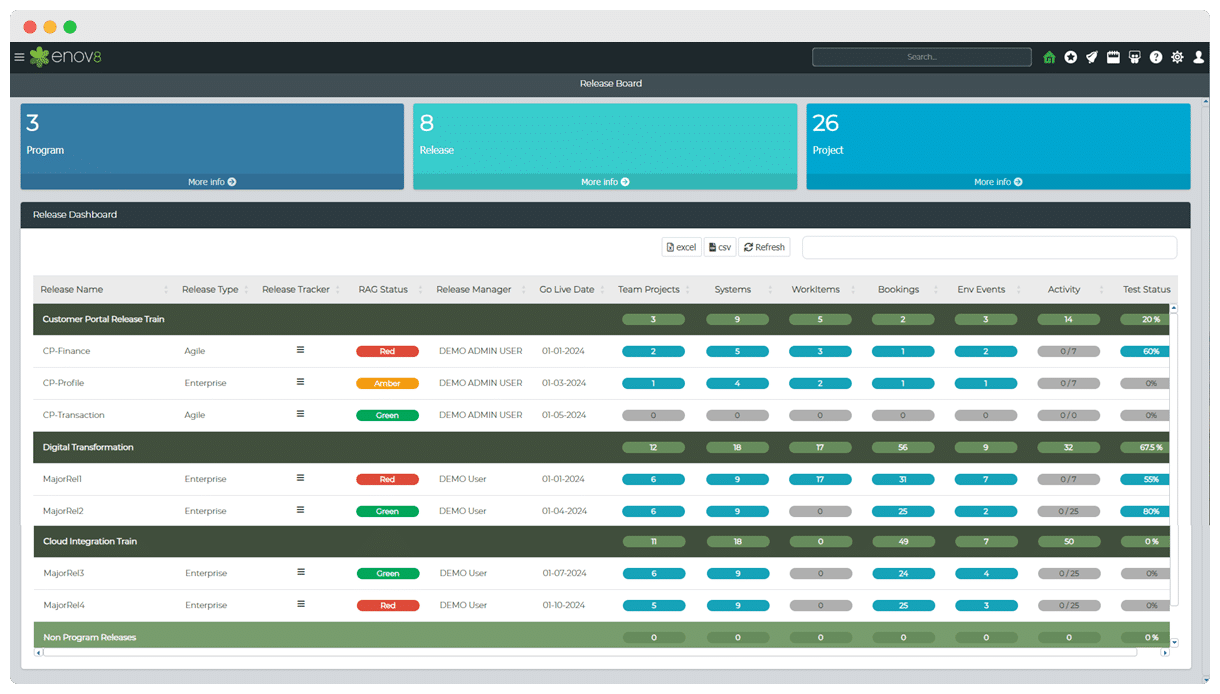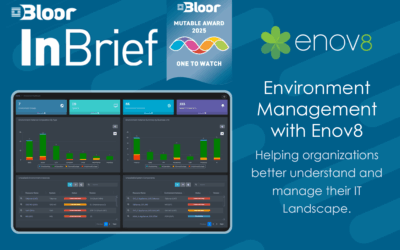
MAR 2023
by Andrew Staples
Author Andrew Staples
Andrew Walker is a software architect with 10+ years of experience. Andrew is passionate about his craft, and he loves using his skills to design enterprise solutions for Enov8, in the areas of IT Environments, Release & Data Management.
Release management, an integral part of the larger Product Lifecycle Management (PLM) process, refers to the process of planning, coordinating, and controlling the deployment of software changes into production environments. It involves the coordination of different stakeholders and the use of various tools and techniques to ensure that software releases are delivered efficiently, effectively, and with minimal risk.
In today’s digital age, software has become an integral part of businesses, and software releases have become more frequent and complex. For large enterprises, managing software releases can be a daunting task that requires a comprehensive strategy and a team of experts. Release management is critical for large enterprises as it helps them to manage the complexity of software releases, reduce the risk of failures and downtime, and ensure that software releases meet the needs of the business.
Enov8 Enterprise Release Manager
*Innovate with Enov8
Streamline delivery of IT change through embracing “Scaled Agile” best practice.
In this post, we will explore the benefits of release management for large enterprises, including the importance of the release-centric approach, governance, maintaining business and IT alignment, and release risk management.
A Release Centric Approach
Release management at the enterprise scale involves managing the release life cycle as a project with defined goals, timelines, and outcomes. This approach helps large enterprises to efficiently manage software releases, reduce the risk of failures and downtime, and ensure that software releases align with business goals.
Focusing on the release life cycle helps large enterprises identify bottlenecks and inefficiencies in the release process, improve collaboration and communication between teams, and ensure high-quality software releases that meet business needs.
Enterprise Release Management (ERM) platforms provide end-to-end visibility and control over the entire release process, from planning to deployment. These tools enable enterprises to identify and mitigate risks, improve collaboration and communication between teams, and accelerate software delivery.
In large enterprises, value streams can comprise multiple release trains, and release trains may consist of multiple value streams. As the number of software applications and delivery accelerates, the risks to releases and the enterprise overall increase. These risks include noncompliance with regulations, security standards, or other governance requirements, release scheduling conflicts, and missing the right features at the right time.
ERM platforms are crucial for mitigating these risks. They allow release managers and other stakeholders to view the application portfolio as a system, provide traceable data for compliance auditing, and offer analytics that alert users of scheduling and timing risks. Consistent governance compliance is achieved by using scalable and repeatable release templates across an enterprise portfolio to ensure governance requirements are consistently followed. ERM platforms enable system-wide scheduling, allowing release managers, PMO, and product managers to plan releases accurately at the enterprise level, taking into account interdependencies, resource requirements, and timing of each release.
Governance
Governance is an essential aspect of release management in large enterprises. It ensures that software releases are aligned with business goals, comply with regulatory requirements and security standards, and are consistent across different teams and departments.
Enterprise Release Management (ERM) platforms play a critical role in enforcing governance policies. They provide a centralized platform for release managers and stakeholders to define, enforce, and audit governance policies across the entire release process.
ERM platforms enable the standardization of release processes, ensuring that governance policies are consistently followed across different teams and applications. This helps to reduce the risk of non-compliance, which can result in fines, loss of customer trust, and reputational damage.
ERM platforms also enable the traceability of release activities, allowing organizations to demonstrate compliance with regulatory requirements and security standards. This is especially important in highly regulated industries such as healthcare and finance.
Furthermore, ERM platforms provide visibility into the release process, allowing stakeholders to identify potential governance risks and take corrective actions in a timely manner. This includes identifying scheduling conflicts, ensuring the availability of required resources, and ensuring that all necessary approvals are obtained before a release is deployed.
Maintaining business and IT alignment
Business and IT alignment is crucial for the success of any enterprise. In order to maintain alignment, it is important to establish and maintain clear communication channels between the business and IT teams. This involves understanding the business objectives and aligning IT initiatives to meet those objectives.
One effective approach to maintain alignment is to use a collaborative approach to develop and prioritize IT initiatives. This involves engaging both business and IT stakeholders in the process to ensure that IT initiatives are aligned with business goals, priorities, and timelines. By involving both teams in the decision-making process, it becomes easier to ensure that everyone is on the same page and working towards the same objectives.
Regular meetings between the business and IT teams are also important to maintain alignment. These meetings should focus on discussing progress towards objectives, reviewing IT initiatives, and identifying any potential roadblocks or issues that may arise. This helps to ensure that everyone is aware of what is happening within the organization and is working towards the same goals.
Another important aspect of maintaining alignment is to ensure that IT initiatives are regularly reviewed and updated to ensure that they continue to meet the needs of the business. This involves regular monitoring of IT initiatives to ensure that they are on track, and making adjustments as necessary to ensure that they are meeting business objectives.
Overall, maintaining business and IT alignment requires a collaborative approach, clear communication, and a commitment to regularly review and update IT initiatives to ensure that they continue to meet the needs of the business.
Enov8 Enterprise Release Manager, Release Planning: Screenshot

Release Risk Management
Effective management of release risk is crucial for enterprises to avoid security vulnerabilities, noncompliance, and other issues that can lead to fines, loss of customer trust, and additional work to bring applications back into compliance. As enterprises continue to accelerate their software delivery, the risks associated with releases and the enterprise overall increase.
To mitigate these risks, Enterprise Release Management (ERM) platforms play a critical role. These platforms provide release managers and other stakeholders with a system-wide view of the application portfolio, allowing for traceable data to ensure compliance auditing and analytics to alert users of scheduling and timing risks.
Consistent governance compliance can be achieved by using scalable and repeatable release templates across an enterprise portfolio to ensure that governance requirements are consistently followed. Traceable data of release activities allows for release audits to verify compliance. ERM platforms also allow release managers, PMOs, and product managers to understand how to accurately plan releases at the enterprise level, taking into account the interdependencies, resource requirements, and timing of each release.
Another crucial aspect of release management in mitigating risks is scoping. Release managers need to constantly balance IT work and business needs. ERM platforms allow release managers to easily increase or decrease the scope of a release to meet release timelines. Teams upstream and downstream can see the current release scope and timing to ensure that everyone is on the same page, and the risk of release failure is controlled.
Conclusion
After considering the benefits of release management for large enterprises, it is clear that having a comprehensive Enterprise Release Management (ERM) platform is crucial for success. The Enov8 Enterprise Release Manager is an excellent option for companies looking for a solution that allows release managers and other stakeholders to see the application portfolio as a system, provide traceable data for compliance auditing, and analytics that alert users of scheduling and timing risks. The platform enables consistent governance compliance, system-wide scheduling, and scoping, which can help enterprises mitigate risks associated with the release process.
In summary, implementing a release-centric approach with the help of an ERM platform like Enov8 Enterprise Release Manager can provide numerous benefits for large enterprises, such as increased efficiency, reduced risk of failures and downtime, and alignment of software releases with business goals. It is a wise investment that can help organizations stay competitive in the fast-paced software industry.
Other ERM Reading
Some more Release Management articles you can read over a coffee:
Enov8 Blog: Release Management Explained in Depth
Enov8 Blog: What is Release Management in ITIL – A Guide and Best Practice
Relevant Articles
DORA Compliance – Why Data Resilience is the New Digital Battlefield
How Enov8 Helps Financial Institutions Align with the EU's Digital Operational Resilience Act Executive Introduction As of January 2025, the EU's Digital Operational Resilience Act (DORA) has become legally binding for financial institutions operating across the...
Data Fabric vs Data Mesh: Understanding the Differences
When evaluating modern data architecture strategies, two terms often come up: data fabric and data mesh. Both promise to help enterprises manage complex data environments more effectively, but they approach the problem in fundamentally different ways. So what’s...
What Is Release Management in ITIL? Guide and Best Practices
Managing enterprise software production at scale is no easy task. This is especially true in today’s complex and distributed environment where teams are spread out across multiple geographical areas. To maintain control over so many moving parts, IT leaders need to...
Test Environment: What It Is and Why You Need It
Software development is a complex process that requires meticulous attention to detail to ensure that the final product is reliable and of high quality. One of the most critical aspects of this process is testing, and having a dedicated test environment is essential...
PreProd Environment Done Right: The Definitive Guide
Before you deploy your code to production, it has to undergo several steps. We often refer to these steps as preproduction. Although you might expect these additional steps to slow down your development process, they help speed up the time to production. When you set...
Bloor Recognizes Enov8 as a Leader in IT Environment Management Innovation
Press Release Sydney, Australia — April 2025 — Enov8, a pioneer in IT & Test Environment, Release, and Data Management, has been recognised by Bloor Research in its latest report for redefining how modern enterprises manage complex IT landscapes. The Bloor...
What is Data Tokenization? Important Concepts Explained
In today’s digital age, data security and privacy are crucial concerns for individuals and organizations alike. With the ever-increasing amount of sensitive information being collected and stored, it’s more important than ever to protect this data from...
Steering Committees in Depth: Understanding their Role
Are you a product owner or technologist looking to understand the role of a steering committee and how it can benefit your organization? Or maybe you're just wandering by and curious about the topic. Either way, we'll explain the steering committee in detail. This...
Everything to Know about Smoke Testing
In the realm of software development, ensuring the reliability and functionality of applications is of paramount importance. Central to this process is software testing, which helps identify bugs, glitches, and other issues that could mar the user experience. A...
Data Leakage Basics: Explanation and Prevention Tips
The benefits of using cloud environments to store and access data over the Internet has been highly beneficial for many businesses. Cloud environments help both start-ups and enterprises scale up conveniently. However, as with other major advancements, the convenience...
Break New Ground In Your Test Environments
Receive the latest news and updates in the test environment space to help you develop a more holistic and effective environment management strategy.
Enov8 is committed to user privacy and will never share your email address.
Whitepapers
Keep up to date with the latest resources, including whitepapers to improve your understanding and knowledge of tools to accelerate digital transformation.
Blogs & Updates
Stay in touch with Enov8 and our wide network. Receive regular updates and insights from the industry, and find out what we're working on!









